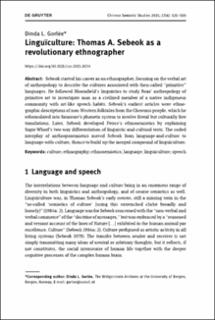Linguïculture: Thomas A. Sebeok as a revolutionary ethnographer
Journal article, Peer reviewed
Published version

Åpne
Permanent lenke
https://hdl.handle.net/11250/2985613Utgivelsesdato
2021Metadata
Vis full innførselSamlinger
- Department of Philosophy [240]
- Registrations from Cristin [9791]
Sammendrag
Sebeok started his career as an ethnographer, focusing on the verbal art of anthropology to describe the cultures associated with then-called “primitive” languages. He followed Bloomfield’s linguistics to study Boas’ anthropology of primitive art to investigate man as a civilized member of a native indigenous community with art-like speech habits. Sebeok’s earliest articles were ethnographic descriptions of non-Western folktales from the Cheremis people, which he reformulated into Saussure’s phonetic system to involve literal but culturally free translations. Later, Sebeok developed Peirce’s ethnosemiotics by explaining Sapir-Whorf’s two-way differentiation of linguistic-and-cultural texts. The coded interplay of anthroposemiotics moved Sebeok from language-and-culture to language-with-culture, thence to build up the merged compound of linguïculture.